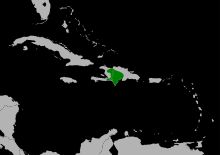Green-tailed warbler
The green-tailed warbler (Microligea palustris), also known as the green-tailed ground warbler, is a species of songbird endemic to the island of Hispaniola (Haiti and Dominican Republic) and adjacent islets. It has occurred as a vagrant on the Turks and Caicos Islands.[1]
| Green-tailed warbler | |
|---|---|
_(8082776636).jpg) | |
| Scientific classification | |
| Kingdom: | Animalia |
| Phylum: | Chordata |
| Class: | Aves |
| Order: | Passeriformes |
| Family: | Phaenicophilidae |
| Genus: | Microligea Cory, 1884 |
| Species: | M. palustris |
| Binomial name | |
| Microligea palustris (Cory, 1884) | |
 | |
| Range of M. palustris | |
Description
The bird is 12–14 cm long, with a long tail, olive green upper-parts, grayish head, face and throat; the under-parts are off-white. The eye, which is red in adults and brown in juveniles, is surrounded by an incomplete white eye-ring. Populations on higher ground tend to be larger and darker than those in lowlands.
Taxonomy
Formerly placed in the New World "warbler" family, Parulidae, as a monotypic genus Microligea. it has been shown to be too distant from the Parulidae proper to be included there. Instead, with good justification from DNA evidence, it has been included in the newly named family Phaenicophilidae along with its sister genus Xenoligea, and the Phaenicophilus palm-tanagers. The population on Beata Island is thought to represent an endemic subspecies: M. palustris vasta.
Behaviour and habitat
The bird is insectivorous and usually rummages close to ground level and in the underbrush. Its natural habitats are subtropical or tropical dry forests, subtropical or tropical moist montane forests, and heavily degraded former forest, ranging in altitude from sea level to montane highs of over 2,500 meters.
References
- BirdLife International (2012). "Microligea palustris". IUCN Red List of Threatened Species. 2012. Retrieved 26 November 2013.CS1 maint: ref=harv (link)
- S. Latta, et al. Aves de la República Dominicana y Haití. Princeton University Press, 2006.
- What is a wood-warbler? Molecular characterization of a monophyletic Parulidae. I. J. Lovette and E. Bremingham. The Auk, No. 119, 2002.
